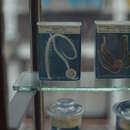Comprehensive Description
provided by Smithsonian Contributions to Zoology
Brisinga endecacnemos Asbjørnsen, 1856
Brisinga endecacnemos Asbjørnsen, 1856:95, pl. 9.—G.O. Sars, 1875:1–112, pl. 4: fig. 41, pl. 7.—Bell, 1892 [1893]:520; 1893:104.—Perrier, 1894:62.—Farran, 1913:27–28.—Gage et al., 1983:284–285.
MERISTICS.—Arms = 11, R = 342 mm, r = 12 mm, R/r = 28.5/1, length of gonadal region = 130 mm, length of longest arm spine = 18 mm.
DIAGNOSIS.—[80.b] Madreporite of moderate size, raised; [100.a] madreporite coarsely channeled; [110.a] abactinal disc plates metapaxillar; [120.b] abactinal disc plates dense, embedded in membrane; [130.a] abactinal disc plates armed with a tiny echinulate spinelet; [170] number of arms 11; [205.a] gonadal region nearly half arm length, moderately inflated; [210.a] abactinal arm plates rod-like; [220.a] abactinal arm plates imbricate, costae meandering, some incomplete, some anastomosing, not widely spaced, membrane between and beyond costae with minute spinelets; [240.a] abactinal arm plates bearing row of fine spinelets; [250.a] terminal plates rather small relative to marginals; [260.a] terminals catsclaw-shaped; [270.a] terminals bearing about 5 slender spines; [280.a] marginal plates very small relative to adambulacrals; [290.b] marginals irregularly oval; [300.b] marginals occurring ring about every other adambulacral; [310.a] marginals bearing each one very long acicular spine; [320.a] adambulacral plates higher than long; [330.b,c] adambulacrals nearly discoid, spool-shaped; [340.b] furrow margin slightly indented; [350] number of furrow spines 1 or 2; [360.a] furrow spines small, acicular; [370.a(a,b)] furrow spines at proximal end of adambulacral if single, one at each end if double; [380] number of subambulacral spines 1; [390.a] subambulacral spines long, acicular; [420.a] ambulacral plates fairly high, heavy; [430.c] head of ambulacrals Y-shaped, larger than base, cylindrical, with inner proximal projection; [470.b] tubefeet rather heavy; [480.a] mouth plates rather small relative to adambulacrals; [490.c] mouth plates longer than broad, subtriangular, truncate; [500] number of preoral spines per mouth plate 1; [510.a] preoral spines acicular, moderately long; [520.a] preoral spines projecting into actinostome; [530] number of lateral oral spines per mouth plate 1; [540.a] lateral oral spines small, acicular; [550.b] lateral oral spines at sides of mouth plates; [560] number of suboral spines per mouth plate 1; [570.a] suboral spines moderately long, acicular; [580.a] suboral spines below preoral spines; [620.a,b(f)] pedicellariae on both abactinal and actinal surfaces, on disc confined to mouth spines, on arms mostly confined to adambulacral spines, very few on membranous areas of arms, in bands; [630.a] all pedicellariae microscopic.
COLOR.—Bright yellow-orange.
TYPE.—Bergens Museum; Hardangerfjord, Norway, 183–366 m.
MATERIAL EXAMINED.—2 lots, 3 specimens in BM(NH).
DISTRIBUTION.—Norway to Portugal; 183–2000 m.
CHARACTERS.—Those peculiar to B. endecacnemos: None.
Characters shared with other species of Brisinga:
B. hirsuta: 80.b, 210.a, 220.a, 240.a, 280.a, 330.b, 340.b, 360.a, 390.a, 420.a, 500.1, 510.a, 530.1, 570.a.
Characters in which B. endecacnemos differs from other species of Brisinga:
B. hirsuta: 100, 110, 120, 130, 170, 205, 290, 300, 320, 380, 430, 470, 480, 490, 520, 550, 580, 620, 630.
- bibliographic citation
- Downey, Maureen E. 1986. "Revision of the Atlantic Brisingida (Echinodermata:Asteroidea), with description of a new genus and family." Smithsonian Contributions to Zoology. 1-57. https://doi.org/10.5479/si.00810282.435

